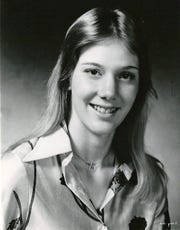For the families of victims killed in unsolved murders, life has been at a standstill for a long time, even before the pandemic arrived.
Over the next several weeks, The Enquirer will highlight a series of cold cases, summarized and analyzed by the journalists whose careers largely focus on unsolved murders: the creators of Cincinnati.com’s Accused podcast. If you have any information on any unsolved case, please reach out to the appropriate law enforcement agency. Suggestions for cases to highlight can be sent to [email protected].
The crime: When Loveland police pulled the body of 19-year-old Cheryl Thompson from the banks of the Little Miami River, they had no idea the case would hang over the department like a fog for the next 42 years.

Cheryl Thompson, 19, disappeared on her way to a disco March 24, 1978. Her body was discovered near the Little Miami River about two weeks later. Loveland, Ohio, police are hopeful that they might break the case with the help of newly found DNA and a genealogy database. (Photo: Provided)
Thompson disappeared March 24, 1978. She had left her home around 10:30 p.m., saying goodbye to her little brother, and set off to meet her boyfriend at a disco in Oakley. She never arrived.
Her boyfriend started searching for her immediately – and even spotted a man driving away in her car around 2 a.m. The boyfriend gave chase but couldn’t keep up and lost the car near Hyde Park Plaza.
As old as this case is, however, there’s new hope thanks to online genealogy databases – and some long-forgotten evidence recently discovered in the Hamilton County coroner’s lab.
“I’m very, very hopeful,” said Loveland Detective Steve Moster, who’s working with a newly formed cold case unit that’s part of Ohio’s Bureau of Criminal Investigation.
The victim: Accused listeners might remember that a spate of young women were slain in the late ‘70s and early ‘80s in the Cincinnati region. Thompson, unfortunately, was among them. A headline in The Enquirer on April 10, 1978 read: “2½-year toll of female murder victims now stands at 16.” The women ranged in age from 12 to 27. Several of the cases remain unsolved today.
In Thompson’s case, the University of Cincinnati freshman had been staying with her parents over spring vacation when she disappeared. Investigators held out hope she’d be found alive until a state game warden checking fishermen’s licenses spotted her body entangled in some brush.
Her date of death isn’t clear. Though she disappeared March 24, her body wasn’t discovered until April 8 – and the coroner at the time estimated she’d been outside decomposing for just a few days.
Dr. Paul Jolly, the county’s chief deputy coroner back in ’78, determined Thompson had been beaten over the head and then strangled. It appeared she had been raped. Most of her clothing was missing, though she was wearing socks, shoes and some jewelry.
Moster, the current investigator on the case, acknowledged that police had saved DNA evidence over the decades but declined to say what type.
The persistence: In 2012, the available evidence – which had been sitting on a shelf in the police department’s evidence room, most of it stored in sealed paper bags – was analyzed and produced a partial profile that didn’t point to anyone whose DNA had been collected at either the state or federal levels.
Investigators had already decided to try uploading that partial profile to a genealogy database when they got some unexpected news: More DNA evidence had been discovered as the coroner’s office cleaned house, getting ready to move into a new building.
“We hope this will bridge the gap to make a complete profile,” said Moster, who’s been familiar with the case since he began working at the department in 1994.
Moster has reason to be hopeful: Law enforcement agencies over the past decade have made huge advances in familiar DNA technology. The highest-profile arrest likely has been Joseph DeAngelo, whose identity as the Golden State Killer was finally discovered in 2018 after more than 40 years of mystery.
Closer to home, William Brian Blankenship of Southgate, Kentucky, was arrested Jan. 23, 2020, after a genealogy database matched his DNA with that collected from rape cases in 1999 and 2001. He faces nine charges in Hamilton County, including burglary, rape and kidnapping.
The evidence: Through Accused, we’ve unfortunately learned that too many police departments don’t hold on to evidence in criminal cases – even if they have no statute of limitations, as is the case with unsolved murders. That Loveland Police has held onto the evidence in Thompson’s case for more than 40 long years is laudable.
“I’m looking at four banker boxes” full of evidence, Moster said over the phone Monday. “It’s been sitting here, year after year.”
Thompson’s parents have since died, but she had two brothers who would still like to know what happened to her.
Got tips? If you know something that might help Moster, submit a tip through the Ohio Attorney General’s Office here: https://www.ohioattorneygeneral.gov/Individuals-and-Families/Victims/Submit-a-Tip/Unsolved-Homicide-Tip.aspx
Accused, reported by Enquirer journalists Amber Hunt and Amanda Rossmann, is an award-winning podcast investigating cold cases with three seasons available on all mainstream platforms such as Apple Podcasts and also at www.accusedpodcast.com.
Read or Share this story: https://www.cincinnati.com/story/accused/2020/10/26/backstory-investigators-hope-dna-might-solve-cheryl-thompsons-1978-slaying/3630172001/

